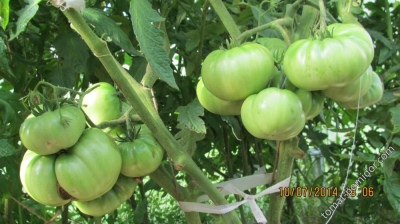
- Authors: Korochkin V.L., Nalizhity V.M., Korotkov S.A., Dynnik A.V., Ilyev P.B.
- Year of approval: 2003
- Category: grade
- Growth type: determinant
- Appointment: fresh consumption
- Ripening period: mid-season
- Ripening time, days: 98-114
- Growing conditions: for open ground
- Marketable fruit yield,%: 65-90%
- Bush size: undersized
Ease of care and incredible taste are what every summer resident chooses. The Russian Bogatyr tomato meets all the necessary characteristics. The variety is suitable for growing in different regions of Russia, but the increased yield will be only in the regions of the Central Black Earth Region.
Breeding history
The originator of the variety is the Moscow Region company "Russian Garden", which at the beginning of the 2000s began to develop a new variety. The authors were V. L. Korochkin, V. M. Nalizhity, S. A. Korotkov, A. V. Dynnik, P. B. Ilyev. private gardens and plantations.
Determinant variety, created for cultivation in the open field in the southern and central regions, in the northern latitudes - in closed greenhouses.
Description of the variety
Due to its characteristics, the variety is considered undersized. On average, the height varies from 60 to 80 cm. Growth will directly depend on the place of cultivation. The bush is compact, the crown is semi-spreading, branched. The trunk is well developed, powerful, with slight pubescence. Despite the fact that the bushes are compact and do not take up much space, they still need to be tied to a support in order to avoid breaking the stem due to the severity of the fruit.
Leaves are medium in size, medium-sized, elongated and pointed towards the end. The color is green, matte. There is roughness on the sheet plate. From drought, the leaves curl up.
The inflorescence is of an intermediate type, begins to form above the 7th leaf. Subsequent - in 1-2. The buds are medium in size, yellow in color. Brushes are formed 6-8. 4-5 berries ripen on one brush. The formation of a bush includes 1 main and 1 side stems.
The Russian Bogatyr tomato has good indicators of productivity and external characteristics. Gardeners note excellent immunity to fungal diseases, keeping quality and transportability. And also unpretentious care.
Among the minuses, pinching and the need for tying to a support are most often noted.
The main qualities of the fruit
The shape of the fruit is round, slightly flattened at the stalk. The weight of vegetables is 92-147 g. The first tomatoes can ripen heavier. Most often this happens on the lower branches - the higher the brush is from the ground, the smaller the berry will be. The color of ripe tomatoes is red or raspberry red, unripe fruits are light green.
The skin is smooth and firm. It prevents the vegetable from cracking. Thanks to this, tomatoes tolerate processing and transportation well.
The pulp is juicy, fleshy, slightly firm and slightly watery. Many small chambers are formed inside; there are few seeds in them.
Berries of a universal type, used fresh and in salads, canned and pickled. Suitable for making sauces, juices, soups, tomato pastes, jams and smoothies.
Taste characteristics
They note the wonderful tomato aroma of the fruits, as well as the rich and bright taste.
Ripening and fruiting
The Russian Bogatyr variety belongs to the group of mid-season crops. Fruit ripening takes 98-114 days. Fruiting occurs in several stages from July to August. Dates may vary depending on the region and weather conditions.
Yield
There is a high yield. 5-6 kg are removed from one bush. On an industrial scale, 291-381 centners of vegetables are harvested from one hectare.
The timing of planting seedlings and planting in the ground
Germinating the seeds of the Russian hero has a standard technology. Even a beginner can handle this process.
Purchased seeds are processed. First, they are soaked in water. Then it is treated with a weak solution of potassium permanganate, and again washed in water.
Soft and loose earth is poured into the seedling boxes. The hole is made no more than 2 cm deep. After sowing, the soil is abundantly moistened, and the boxes are covered with foil. The temperature should be +25 degrees. This will be optimal for seed germination. They should hatch in a week.
A pick should be done after the plant has a couple of strong leaves. Loose earth is poured into the container together with fertilizers and plentifully spilled with water. Seedlings are best placed on a windowsill, as they need sunlight. If the sun is not enough, then it is better to resort to UV lamps. Then the development of the future bush will take place evenly, and the stems will not be excessively stretched.
Disembarkation is carried out from May 15 to June 5. It is best not to rush with this, since the culture is thermophilic and does not tolerate excessive temperature changes.
The site is prepared in advance, dug up along with fertilizers and spilled with water.

Growing tomato seedlings is an extremely important process, because it largely depends on whether the gardener will be able to harvest at all. All aspects must be taken into account, from seedbed preparation to planting in the ground.
Landing scheme
It is best to plant the bushes according to the scheme 50x40 cm.The depth of the hole is no more than 15-20 cm.

Growing and care
Proper care should include:
regular watering (2 times a week);
pinching;
top dressing (every 14 days);
loosening the soil and removing weeds;
airing the greenhouse;
garter for pegs;
preventive spraying.




A plant needs different micronutrients at each stage of growth. All fertilizers can be divided into two groups: mineral and organic. Folk remedies are often used: iodine, yeast, bird droppings, eggshells.
It is important to observe the rate and period of feeding. This also applies to folk remedies and organic fertilizers.



























































































